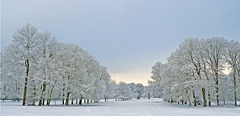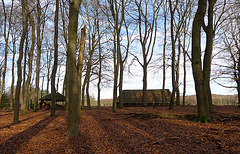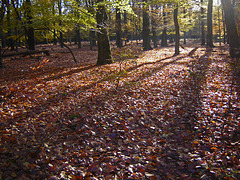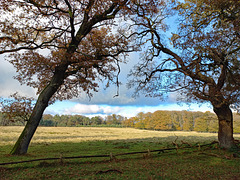
Apeldoorn
Nederland - Hoog Soeren
| |
|
|
|
Hoog Soeren: quiet village during ( ↑ ) and before ( ↓ ) the corona crisis.
Even before the beginning of our era, Germanic tribes had settlements in the area where the village of Hoog Soeren is situated. The early 20th century excavated urns from burial mounds are reminders of this. Hoog Soeren is one of the oldest settlements in the Veluwe and originated on high dry parts of the Veluwe. The proximity of some fens made an existence here possible.
Early 9th century the village was mentioned as Suornom or Suornum. It had several other names before the village became in the mid 19th century its current name. This may be derived from the Old Saxon “sôr”, which means “arid” or “dry”. Not strange as Hoog Soeren is located on a height of 85 meters, a high and dry part of the Veluwe, the largest nature area in the Netherlands.
Hoog Soeren is surrounded by the woods of the Kroondomein Het Loo (Het Loo Royal Estate) and is a protected village area. It has only three paved roads with a name, all other houses along dirt roads have as address the name of the village with a number.
Until the end of the 19th century, Hoog Soeren was an agricultural community, which developed into a settlement for forest workers, foresters and gamekeepers. In the 1930’s many local people had to sell their farm and land. From that period on, a village with civilian houses gradually came into being and became a popular settlement for wealthy people from the western part of the country. A number of farms were transformed into residential houses, but many new houses were built as well. In the first half of the 19th century the area also became a tourist attraction - with some hotels and guesthouses - and an attractive place to live and stay for wealthy people.
Nowadays Hoog Soeren has about 250 permanent inhabitants, living in 100 houses. It has no school either a shop, but a lovely little village church, which was built in 1904.
Nederland - Hoog Soeren, Kapel
Nederland - Hoog Soeren
| |
|
|
|
Grove of trees on the golf course of the Veluwse Golf Club.
PiP's: During winter (and snow) no golf players but children using their sleds.
Apeldoorn - Hoog Soeren, Groene Poeltje
| |
|
|
|
The Groene Poeltje (Little Green Puddle) is situated just outside the village of
Hoog Soeren in a small valley of a hill named Pomphul . The valley with the puddle has probably already had an attraction and significance for the inhabitants of this elevated part of the Veluwe in prehistoric times. The nearby burial mounds in prove that people lived here from an early age.
Due to the high altitude of Hoog Soeren, obtaining sufficient drinking water was often a problem in the past. Around 1800 a pump was installed in the valley of Pomphul. When in summer the rain barrels and wells in Hoog Soeren were dry, the villagers had to fetch water from Groene Poeltje with a barrel on a barrow. The trip with the heavy barrow back up to the village was quite a job. In 1927 the village became its own water piping.
Since the 17th century, however, a water pipe made of lead, wooden and earthenware pipes ran from Pomphul to the gardens of Het Loo Palace . The construction of this 13-kilometer long pipeline was commissioned by king Willem III. The difference in height of about 30 meters caused an enormous water pressure. The final result were 20 fountains, each 4 meters high and one fountain 13 meters high; the highest spouting fountain in Europe !!
Nederland - Hoog Buurlo
Nederland - Hoog Buurlo
| |
|
|
|
Hoog Buurlo is a agricultural enclave amidst heathland, woods and beech avenues. Field farming, keeping sheep and chopping oak (tannic acid from oak bark was used in the tannery) provided the necessary income. Hoog Buurlo is most probably the smallest hamlet of the Netherlands, with two former farmhouses, two sheepfolds, just a couple of residents and over a hundred sheep.
The name (Hoog) Buurlo appears already in the 9th century and is a combination of "bur" (small house) and "lo" (forest). The hamlet is well known for its sheepfold and herd. It attracts many visitors, especially in spring when lambs are born.
Nederland - Radio Kootwijk
Nederland - Radio Kootwijk, De Kathedraal
| |
|
|
|
After World War I the Netherlands decided to set up their own international communication network. This enabled a permanent connection with the Dutch East Indies. A search was made for an uninhabited, remote area for placing a broadcasting station. This was found in the Veluwe, where 450 hectares of land was purchased from Staatsbosbeheer (Dutch State Forest Commission).
About 150 labourers from Amsterdam levelled the terrain. The antenna terrain was constructed as a circular plain with a diameter of approximately 1.200 meters, a ring of five 212 meters high masts around a central mast at the foot of the transmitter building. The radio transmission centre was officially put into operation in May 1923, initially for Morse telegraph traffic.
Not only buildings were built for the broadcasting system, but also houses, workshops and a water tower were erected. The entire village was named after its function: Radio Kootwijk. In the late 1920s, around 200 people lived in Radio Kootwijk. The village was remote and there was no regular bus connection with villages in the area. That is why the community arranged a school bus, a market bus, a football bus and even a church bus on Sundays. The village also had its own fire brigade, garbage collection service, electricity and water via the water tower and pumps.
The architect of the main building - officially called “Building A”, but well known by its nickname “De Kathedraal” - was architect Julius Luthmann, who worked for the Dutch Government Building Agency. The building could, for example, not be built in wood because of the fire hazard of overheating due to radiation from the transmitters. The sending station therefore consists of reinforced concrete, in the form of a sphinx (the architect was interested in Egyptian mythology). The style from which it is executed is a mixture of German expressionism and the Amsterdam School, with some Scandinavian influence. Luthmann worked with the sculptor Hendrik van den Eijnde for the decoration.
As of 1962 the transmitter station provided long-distance connections for the maritime industry from the Netherlands. In 1998 the station finally closed it doors. The buildings and corresponding terrain went back to the hands of the Dutch State Forest Commission. Nowadays it is used as venue and scenery for several cultural events and productions. Visitors are welcome on certain days.
Nederland - Assel, Heilige Geest Kapel
| |
|
|
|
Assel is a small hamlet with just more than ten houses. It also has a natural cemetery with a little chapel: Heilige Geest Kapel (Holy Ghost Chapel). This chapel was built in 1940 for the Catholics of Radio Kootwijk, because there was no church for them in the vicinity. The inhabitants raised money themselves and thus the church could be built on a piece of land that was donated. The rectangular brick chapel was built after a design by architect Jan van Dongen Jr., who was also the master builder of two other catholic churches in Apeldoorn.
The chapel is part of the Westerwolde estate, which was founded by the Amsterdam lawyer W.J.M. Westerwoudt. The chapel is surrounded by hundreds of graves of the first natural cemetery of the Netherlands. Since 1955 the cemetery is open for not-relatives of the owners. The walled family cemetery (PiP 2) - on the tower side of the chapel - is separate from the natural cemetery. Five members of the Westerwoudt family are buried there.
Nowadays every Sunday the Heilige Geest Kapel is till used for services for believers from the area and for people who have buried their families and acquaintances here. The chapel is also rented out for funeral services, weddings and even concerts.
Nederland - Hoog Soeren, Het Aardhuis
| |
|
|
|
Het Aardhuis was commissioned by King Willem III and designed by court architect Henri Camp in 1861. Originally, the chalet-like building was mainly used as a military meeting centre and as a place to rest after a hunt. Prince Hendrik also liked to stay in Het Aardhuis which he used while hunting. That is why it is mainly known as a hunting chalet.
Het Aardhuis is situated on the Aardmansberg (from which the name is derived), which at 102 metres is one of the highest points in the Veluwe. This location offered Willem III a magnificent view of the manoeuvres that the soldiers from a nearby camp were performing on the heathlands.
In 1972, Queen Juliana decided to give the impressive black wooden building a different purpose. From a hunting chalet, it became an information centre about nature and wildlife. Today, the ground floor of Het Aardhuis houses a café-restaurant. On the first floor, one of the rooms is still furnished as it was in the days of King Willem III and Prince Hendrik, with a lot of attention for hunting (PiP3). Another larger room serves as an information centre for Kroondomein Het Loo (Het Loo Royal Estate).
Nederland - Hoog Soeren, Aardhuispark
| |
|
|
|
The Aardhuispark is a fenced-off part of Kroondomein Het Loo (The Loo Royal Estate). It is situated - as the name suggests - around Het Aardhuis . The park offers a mixture of open landscape with a wildlife meadow, lanes with old beech and oak trees and water pools.
A three-kilometre walking route has been marked out in the park. This route also leads to a hideout for wildlife spotting. During my last visit, I saw a group of 15 to 20 deer grazing and resting there (PiP1).
Nederland - Nieuw Milligen, Kootwijkerveen
| |
|
|
|
Unlike the name suggests, the Kootwijkerveen is not located near Kootijk, but somewhere hidden in the woods between the hamlets of Nieuw Milligen and Assel. It is a nature reserve that is unusual for the Netherlands: a peat lake surrounded on all sides by wooded shifting sand hills.
The Kootwijkerveen has a long history that goes back to the Ice Age. It was originally a marshland area on the western slope of the Veluwe . Because of an impermeable layer, the water remains there and creates ideal conditions for the formation of moor peat.
Peat was extracted here up until the Second World War. Later, pasture land was created. In the 1970s, the Dutch government organisation for forestry and the management of nature reserves ( Staatsbosbeheer ), began restoration work. The result is a beautiful lake at 40 metres above sea level: a wet oasis in the middle of dry sandy soil; created by ice ages, peat cutters and nature managers.
The Kootwijkerveen can be visited along a signposted walking route, which starts at a car park near Nieuw Milligen.
Nederland - Hoenderloo, Heldringkerk
| |
|
|
|
The Heldringkerk was built in 1857-1858, commissioned by the Reverend Ottho Gerhard Heldring. The foundation stone was laid by his daughter on 29 August 1857. The consecration of the church took place in 1858 during the feast of Pentecost. The church is one of the oldest buildings of Hoenderloo .
Heldring visited the village of Hoenderloo in 1839 and decided to offer a better future to the inhabitants, who still lived partly in sod huts. He did this by building a school, digging a well and constructing the church and clergy house.
The simple hall church - in neo-Gothic style - is characterised by plastered and white-painted facades. The church is built in a hilly area and is therefore popularly called de witte kerk op de bult (“the white church on the hill”). But the white colour was only given to the originally grey church in 1980. Since 2000 the church is a national monument.
Jump to top
RSS feed- Latest items - Subscribe to the latest items added to this album
- ipernity © 2007-2024
- Help & Contact
|
Club news
|
About ipernity
|
History |
ipernity Club & Prices |
Guide of good conduct
Donate | Group guidelines | Privacy policy | Terms of use | Statutes | In memoria -
Facebook
Twitter













